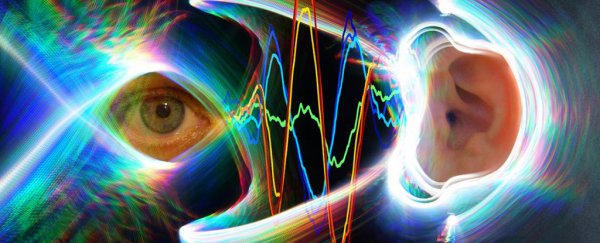If you stick a tiny microphone inside the ear canal, you can discover that our eardrums actually move in conjunction with eye movement.
This bizarre finding has been verified in both humans and rhesus monkeys, but the researchers are not sure why this is happening.
The study, led by a team of neuroscientists from Duke University, was set up to investigate how our brains coordinate input from the two senses - vision and hearing.
Things can get pretty crowded in the neural pathways that process the information bombarding our senses from the outside. Furthermore, the brain also has to line up the inputs - such as when you're having a face-to-face conversation with someone.
"Our brains would like to match up what we see and what we hear according to where these stimuli are coming from, but the visual system and the auditory system figure out where stimuli are located in two completely different ways," says senior author of the study, neurobiologist Jennifer Groh from Duke University.
Seeing something with your eyes means getting a sort-of snapshot travelling from your eyeballs in your face right to the back of your skull where the occipital lobe sits.
But listening is even more complicated - the brain is constantly calculating how to translate the vibrations in your ears based on the timing of the sounds and the direction of where they're coming from.
In this study, the team recruited 16 participants to sit in a darkened room with tiny microphones stuck in their ears to measure any vibrations of the eardrums.
The task was to follow LED lights as they shifted in a controlled pattern from one side to the other. Sometimes, a sound would accompany the lights, and at other times, it would be totally silent.
"We found that the eardrum moved when the eyes moved, even in the absence of any externally delivered sounds," the team writes in the study.
More specifically, when the eyes moved to one side, both of the eardrums synchronically bulged to the other, then vibrated for a few oscillations, and came to a stop shortly after the eyes stopped moving. (Try moving your eyes and see if you can feel it in your ears.)
"It's like the brain is saying, 'I'm going to move the eyes, I better tell the eardrums, too,'" says Groh.
If you're familiar with the classic "sound wave hits eardrum, eardrum starts vibrating and knocking about the bones in the middle ear" model, you might be surprised to learn that the brain can actually step into that process directly by producing movements in those small bones, and also in a special type of hair cell in the cochlea.
This, in turn, causes small eardrum vibrations, which is what the team detected in the study. They're not sure why this is happening, but they have some ideas.
"The fact that these eardrum movements are encoding spatial information about eye movements means that they may be useful for helping our brains merge visual and auditory space," says co-first author of the paper, Duke University doctoral student David Murphy.
"It could also signify a marker of a healthy interaction between the auditory and visual systems."
The team notes their findings contribute to the idea that the brain integrates sensory information very, very early in the process of making sense of it, in order to "make the best-informed decision about the world with which it has to interact."
"The eardrum movements literally contain information about what the eyes are doing," says Groh.
Their work is now cut out to discover more about these joint eye-ear movements - one of the future steps will be to find out whether eardrums also vibrate when we move the eyes up and down.
The study was published in PNAS.
